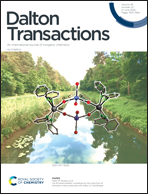Zn(ii), Cd(ii) and Hg(ii) saccharinate complexes with 2,6-bis(2-benzimidazolyl)pyridine as promising anticancer agents in breast and lung cancer cell lines via ROS-induced apoptosis†
Abstract
New Zn(II), Cd(II) and Hg(II) complexes of saccharinate (sac) and 2,6-bis(2-benzimidazolyl)pyridine (bzimpy), [Zn(bzimpy)2](sac)2·2H2O (Zn), [Cd(sac)2(bzimpy)] (Cd) and [Hg(sac)2(bzimpy)] (Hg), were prepared and fully characterized by spectroscopic methods and X-ray crystallography. In vitro anticancer screening in A549 (lung), MCF-7 (breast) and HT29 (colon) cell lines showed that Zn was highly cytotoxic against A549 and MCF-7 cells with IC50 values of 1.74 ± 0.06 and 3.15 ± 0.10 μM, respectively, and Hg demonstrated potent cytotoxic activity in MCF-7 cells (8.61 ± 0.98 μM), while Cd and bzimpy exhibited moderate growth inhibitory activities in all of the cell lines. In addition, they showed significantly lower toxicity towards normal human breast epithelial MCF10A cells. Moreover, the complexes exhibited significantly high nuclease activity towards plasmid DNA and their interactions with DNA were assessed by gel electrophoresis and DNA docking. Zn and Hg induced G0/G1 cell arrest and apoptotic cell death detected via typical DNA condensation/fragmentation, annexin V staining and caspase 3/7 activity in A549 and MCF-7 cells. These complexes further caused depolarization of mitochondria and oxidative damage of genomic DNA following excessive production of reactive oxygen species (ROS).



 Please wait while we load your content...
Please wait while we load your content...